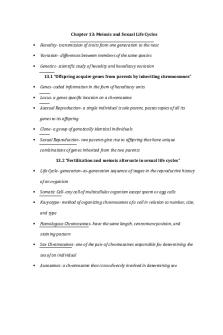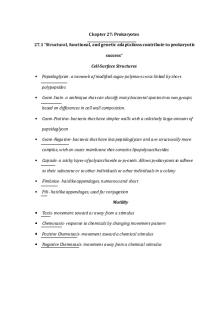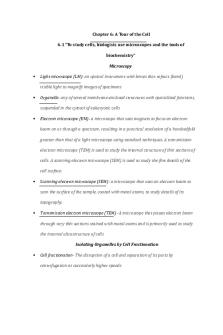Chapter 11 Vocab - Summary Campbell Biology PDF

| Title | Chapter 11 Vocab - Summary Campbell Biology |
|---|---|
| Course | Introduction to Biology A |
| Institution | University of Pennsylvania |
| Pages | 3 |
| File Size | 75.3 KB |
| File Type | |
| Total Downloads | 8 |
| Total Views | 135 |
Summary
Vocab definitions...
Description
Chapter 11: Cell Communication 11.1 “External signals are converted into responses within the cell” Evolution of Cell Signaling
Signal transduction pathway - a series of steps linking a mechanical, chemical, or electrical stimulus to a specific cellular response Local and Long-Distance Signaling
Local regulators- a secreted molecule that influences cells near where it is secreted
Hormones- in multicellular organisms, one of many types of secreted chemicals that are formed in specialized cells, travel in body fluids, and act on specific target cells in other parts of the body, changing the target cells' functioning. Hormones are thus important in long-distance signaling 11.2 “Reception: A signal molecule binds to a receptor protein, causing it to change shape”
Ligand- a molecule that binds specifically to another molecule, usually a larger one Receptors in the Plasma Membrane
G protein-coupled receptor- a signal receptor protein in the plasma membrane that responds to the binding of a signaling molecule by activating a G protein. Also called a G protein-linked receptor
G protein- a GTP-binding protein that relays signals from a plasma membrane signal receptor, known as a G protein-coupled receptor, to other signal transduction proteins inside the cell
Receptor tyrosine kinases (RTK) - a receptor protein in the plasma membrane that responds to the binding of a signal molecule by catalyzing the transfer of phosphate groups from ATP to tyrosines on the cytoplasmic side of the receptor. The phosphorylated tyrosines activate other signal transduction proteins within the cell
Ligand-gated ion channel- a transmembrane protein containing a pore that opens or closes as it changes shape in response to a signaling molecule (ligand), allowing or blocking the flow of specific ions; also called an ionotropic receptor 11.3 “Transduction: Cascades of molecular interactions relay signals from receptors to target molecules in the cell” Protein Phosphorylation and Dephosphorylation
Protein kinase- an enzyme that transfers phosphate groups from ATP to a protein, thus phosphorylating the protein
Protein phosphatases- an enzyme that removes phosphate groups from (dephosphorylates) proteins, often functioning to reverse the effect of a protein kinase Small Molecules and Ions as Second Messengers
Second messengers - a small, nonprotein, water-soluble molecule or ion, such as a calcium ion (Ca2+) or cyclic AMP, that relays a signal to a cell's interior in response to a signaling molecule bound by a single receptor protein
Cyclic AMP
Cyclic AMP (cAMP)- cyclic adenosine mono phosphate, a ring-shaped molecule made from ATP that is a common intracellular signaling molecule (second messenger) in eukaryotic cells. It's also a regulator of some bacterial operons
Adenylyl cyclase- an enzyme that converts ATP to cyclic AMP in response to an extracellular signal Calcium Ions and Inositol Triphosphate (IP3)
Inositol triphosphate (IP3)- a second messenger that functions as an intermediate between certain signaling molecules and a subsequent second messenger, Ca2+, by causing a rise in cytoplasmic Ca2+ concentration
Diacylglycerol (DAG)- a second messenger produced by the cleavage of the phospholipid PIP2 in the plasma membrane 11.4 “Response: Cell signaling leads to regulation of cytoplasmic activities or transcription”
Scaffolding proteins- a type of large relay protein to which several other relay proteins are simultaneously attached, increasing the efficiency of signal transduction...
Similar Free PDFs
Popular Institutions
- Tinajero National High School - Annex
- Politeknik Caltex Riau
- Yokohama City University
- SGT University
- University of Al-Qadisiyah
- Divine Word College of Vigan
- Techniek College Rotterdam
- Universidade de Santiago
- Universiti Teknologi MARA Cawangan Johor Kampus Pasir Gudang
- Poltekkes Kemenkes Yogyakarta
- Baguio City National High School
- Colegio san marcos
- preparatoria uno
- Centro de Bachillerato Tecnológico Industrial y de Servicios No. 107
- Dalian Maritime University
- Quang Trung Secondary School
- Colegio Tecnológico en Informática
- Corporación Regional de Educación Superior
- Grupo CEDVA
- Dar Al Uloom University
- Centro de Estudios Preuniversitarios de la Universidad Nacional de Ingeniería
- 上智大学
- Aakash International School, Nuna Majara
- San Felipe Neri Catholic School
- Kang Chiao International School - New Taipei City
- Misamis Occidental National High School
- Institución Educativa Escuela Normal Juan Ladrilleros
- Kolehiyo ng Pantukan
- Batanes State College
- Instituto Continental
- Sekolah Menengah Kejuruan Kesehatan Kaltara (Tarakan)
- Colegio de La Inmaculada Concepcion - Cebu















